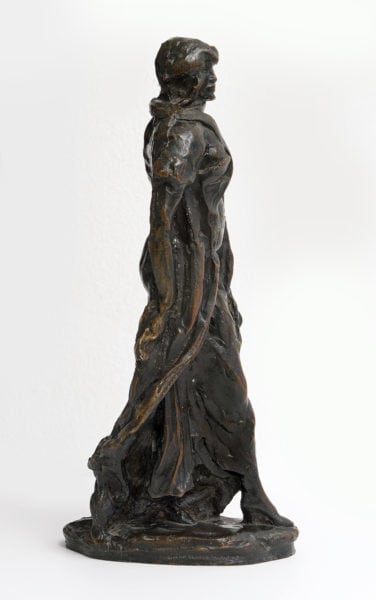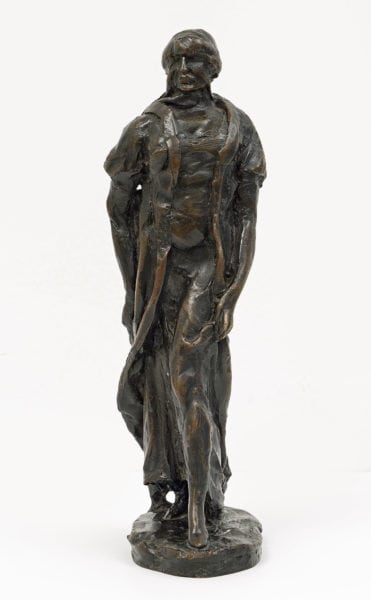Woman Walking, Circa 1911; cast circa 1917
Gaston LachaiseBronze
11 1⁄4 inches high
Inscribed: G. LACHAISE
Inscribed on underside: 4
Stamped: ROMAN BRONZE WORKS N–Y–
Provenance
C.W. Kraushaar Art Galleries, New York
Gerald Peters Gallery, New York City
Private Collection, New York, from the above
According to Gaston Lachaise himself, the model for Woman Walking was created in about 1911, that is, shortly before he moved from Boston to New York City and began his early masterwork, Standing Woman (Elevation) ([LF 55] (1912–15; first cast in bronze in 1927; The Art Institute of Chicago). It was one of the statuettes he cast in bronze in about 1917 in preparation for his first solo exhibition, held at the Bourgeois Galleries, New York, in early 1918. (Whether the work appeared in that show is not known.) The statuette represents a fashionable young woman captured in dynamic motion, the veil of her hat pressed against her face as she strides forward. The statuette was evidently created by Lachaise in response to the beautiful American women who passed him on the street, a subject deliberately chosen to express his desire to seek artistic inspiration from the vitality of daily life around him, not from repeating art of the past—an approach he publicly articulated at the time of the show and more fully in the following year in an essay for a group exhibition at the Bourgeois Galleries in 1919 (Gaston Lachaise, “Modern Sculptures,“ in Exhibition of American Sculptures, exhibition catalogue, New York: Bourgeois Galleries, 1919, [n.p.]).
The sculptor revisited the theme of an energetically striding, contemporary American woman in his famous Walking Woman [LF 31] modeled in 1919, and first cast in bronze several years later (The Museum of Modern Art, New York; and the Currier Museum of Art, Manchester, New Hampshire). According to Lachaise, the subject of Walking Woman [LF 31] is his wife (Interview, New York Herald-Tribune, January 14, 1935, p. 7). It is very likely that the earlier statuette is also inspired by her.
Exhibited
- New York, Museum of Modern Art, Gaston Lachaise: Retrospective Exhibition, January 30–March 7, 1935.
- Buchholz Gallery, New York, Early Work by Contemporary Artists, November 16–December 4, 1943, no. 27.
- New York, Whitney Museum of American Art, Pioneers of Modern Art in America, April 9–May 19, 1946
- New York, Gerald Peters Gallery, Cast and Carved: American Sculpture 1850–1950, November 9–December 10, 2004
- New York, New York, Gerald Peters Gallery, Georgia O’Keeffe and Other Modernists, October 29– December 18, 2009.
- Santa Fe, New Mexico, Gerald Peters Gallery, Works by Gaston Lachaise: A Modern Epic Vision, August 10–September 22, 2012, traveled to Gerald Peters Gallery, New York, New York, November 15–December 21, 2012.
Literature
- Lincoln Kirstein, Gaston Lachaise: Retrospective Exhibition, New York: Museum of Modern Art, 1935, no. 2.
- Buchholz Gallery, New York, Early Work by Contemporary Artists, New York: The Gallery, 1943, [n.p.], no. 27
- Lloyd Goodrich, Pioneers of Modern Art in American, New York: Whitney Museum of American Art, 1946, p. 23, no. 67.
- Alice Levi Duncan, Cast and Carved: American Sculpture 1850–1950, New York: Gerald Peters Gallery, p. 120 (where the cast is mistakenly reported to have belonged to Marvin Korman)
- Virginia Budny, “Gaston Lachaise’s American Venus: The Genesis and Evolution of Elevation,” The American Art Journal, vols. 34–35 (2003–04), p. 134, fn. 48.
- Alice Duncan, ed., Works by Gaston Lachaise: A Modern Epic Vision, Santa Fe and New York: Gerald Peters Gallery, 2012, plate 3.


